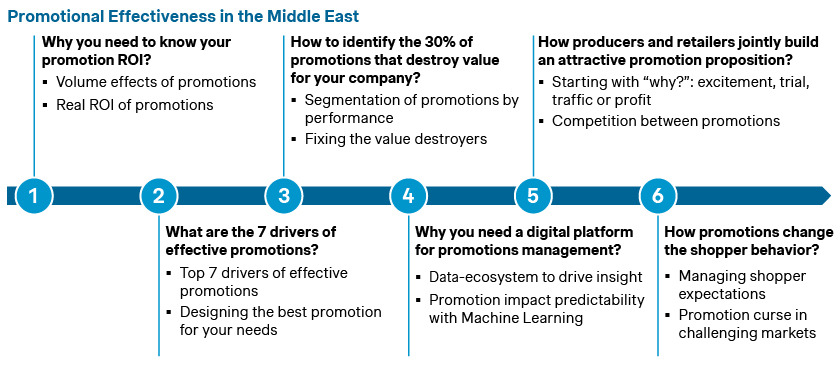Promotional effectiveness in the consumer sector is crucial in the Middle East. Consumer companies must understand the nuances of this region and tailor promotional strategies effectively.
Our article series, Promotional Effectiveness in the Middle East, discusses six pillars for successful promotions. In part one, our local expert Lovrenc Kessler covers everything you need to know for calculating promotion ROI.

Home to a diverse population with varying cultural backgrounds, preferences, and purchasing behaviors, the Middle East has been experiencing significant economic growth, leading to an increase in disposable income and consumer spending. However, the region’s consumer sector is highly competitive, with numerous local and international brands vying for market share.
One way to capitalize on this growing consumer base, drive sales growth, and attract customers is through promotions. Unfortunately, the competition has already had the same idea.
Today it seems like promotions are everywhere and running constantly. Visit your local mall and you will likely be overwhelmed by the “% off” signs and abundance of special offers. It’s a wonder that anyone is willing to pay full price anymore. This bombardment is changing the behavior of consumers, who are becoming all too used to buying most of their everyday need products on promotions only. As a consequence, companies are starting to experience increasing adverse effects surrounding their campaigns. Promotional effectiveness needs to be brought under the microscope, with a critical look at whether these campaigns are actually bringing in the desired results.
When I ask clients about their most successful promotion of the year, the most common answer is “the one that generated the highest sales volume”. But is this really the best measure of promotional effectiveness? While volume uplift should be one of the main goals of promotions, the Return on Investment (ROI) is the most important KPI to separate successful promotions from unsuccessful ones.
However, effectively measuring the ROI of a promotion is not always plain sailing. It requires thorough data collection from multiple sources and involves quantifying the impact of several effects. The first step to calculate promotion ROI is to understand the source of the sales volume that a promotion generates. Here are five sales volume effects that every promotions manager should know:
1. Baseline: Unless you know your regular sales volume, you won’t be able to understand how much volume is driven by the promotion. If your productions weren’t on offer, how much would you still sell to your loyal customers?
2. Forward buying: Don’t forget the volumes drop just after the promotion. Known as consumer stock-up, the additional sales generated during a promotion often result in fewer sales (promo dip) in the days that follow.
3. Cannibalization: What impact does the promoted product have on the sales volume of your remaining products in the category? Or does volume from other non-promoted products prevent the promoted products from achieving high volumes?
4. Competitors’ volumes: You need also need to be able to quantify the impact your promotion had on the competition (often requiring expert judgement). How much of the additional volume is stolen from substitutive competitor products?
5. Category incremental: You will likely trace some of the increased sales volume back to consumers who only purchased the product because it was on promotion in the first place.
Once you understand how much of your promoted volume is incremental and where the sales volumes are coming from, the second step is to understand the impact that each of these five effects has on promotion ROI. Here I recommend starting with a very simple calculation:
Incremental volume = competitor + category volume
The real volume uplift, as I like to call it, is the sum of the additional volume redirected from competitors (effect 4) and the category’s incremental volume (effect 5). Then, we also need to take into account the direct impact that effects 1 to 3 have on ROI. This impact can be summarized as the three ‘hidden’ promotional costs:
1. Cost of subsidy: When you sell the product at a discounted price to consumers that would have purchased the product even without a promotion (baseline), you will naturally forego some revenues.
2. Cost of consumer stock-up: When you experience a volume increase at a discounted price, this may be to the detriment of sales at a regular price outside of promotion.
3. Cost of cannibalization: When you sell the promoted product at a discounted price in place of other products at a regular price, some revenues will be lost. Technically, this effect can be positive if you are able to up-sell from less profitable products. But in my experience, price promotions are rarely an effective up-selling tool.
The third and final step to calculate promotion ROI is to consider the costs directly derived from the promotion. These costs vary per industry and across the value chain. The most common are:
- Slot fees charged by retailers for featuring promotions on leaflets/catalogues
- Display/advertising costs from improving the in-store display or advertising the promotion in and/or outside the point of sale
- Costs from free samples and products
Once you have calculated all of the volume effects and costs, effectively calculating the promotion ROI is a rather straightforward task. The return of a promotion can be calculated as the sum of all promotional costs, including both “hidden” and direct costs, divided by the profit generated from the promotion:
ROI = net profit impact/promotion investment
Why you need to know your promotion ROI
Promotions don’t just change customer behavior, they also affect a company’s profits. Knowing your promotion ROI and volume uplift is key to understanding the real impact of your promotions. While conducting a reliable promotion analysis can be a challenge for companies across the Middle East, there is a lot of information held in these simple, yet effective KPIs.
Read more from our promotional effectiveness series in the Middle East:
Part 2: The 7 drivers of effective sales promotions in the UAE
Part 3: Promotion effectiveness in MENA: How to fix the 30 percent of value-destroying promotions
Part 4: Digital promotions in MENA: Advantages of promotion database management
Part 5: 5 rules for producers and retailers to jointly build customer-centric promotions
Part 6: Promotion effectiveness in MENA: How do promotions change shopper behavior in the long term?








